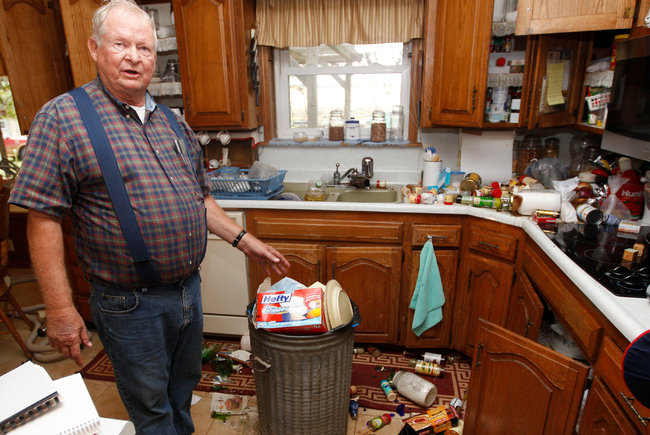http://www.commondreams.org/headline/2013/12/13-1
Published on Friday, December 13, 2013
Pumped underground using disposal wells, the leftover water from oil and gas drilling is literally shifting the ground beneath communities
– Jon Queally, staff writer

Joe Reneau showing damage from two earthquakes to his home in Sparks. (Photo: Sue Ogrocki/Associated Press)In Oklahoma, the oil and gas industry have drilled more than 4,000 “disposal wells” designed to hold wastewater produced from the tens of thousands of extraction drilling sites scattered throughout the state.
But as those wells have grown in number and the millions of gallons of wastewater—generated as an inevitable bi-product from the fossil fuel industry—are pumped into the seems of the earth beneath, something else is happening. Earthquakes. And lots of them.
As the New York Times reports Friday:
Oklahoma has never been known as earthquake country, with a yearly average of about 50 tremors, almost all of them minor. But in the past three years, the state has had thousands of quakes. This year has been the most active, with more than 2,600 so far, including 87 last week.
While most have been too slight to be felt, some […] have been sensed over a wide area and caused damage. In 2011, a magnitude 5.6 quake — the biggest ever recorded in the state — injured two people and severely damaged more than a dozen homes, some beyond repair.
Though hydraulic fracturing, or fracking, is among the many extractive practices now believed to cause earthquakes, Austin Holland, a seismologist with the Oklahoma Geological Survey, told the Times that “disposal wells pose the biggest risk.”
“Could we be looking at some cumulative tipping point? Yes, that’s absolutely possible,” Dr. Holland said.
As the Times explains, experts say that wastewater wells are especially pernicious because of their number and size:
Along with oil and gas, water comes out of wells, often in enormous amounts, and must be disposed of continuously. Because transporting water, usually by truck, is costly, disposal wells are commonly located near producing wells.
Though the disposal of oil and gas wastewater has been ongoing for some time, experts say that the scale and locations of the practice that have changed, mostly because of the boom in oil and gas fracking, which is being done in places with unique underground shale formations.
“People are disposing of fluids in places they haven’t before,” Cliff Frohlich, a University of Texas scientist, told the Times.
____________________________________________
This work is licensed under a Creative Commons Attribution-Share Alike 3.0 License.